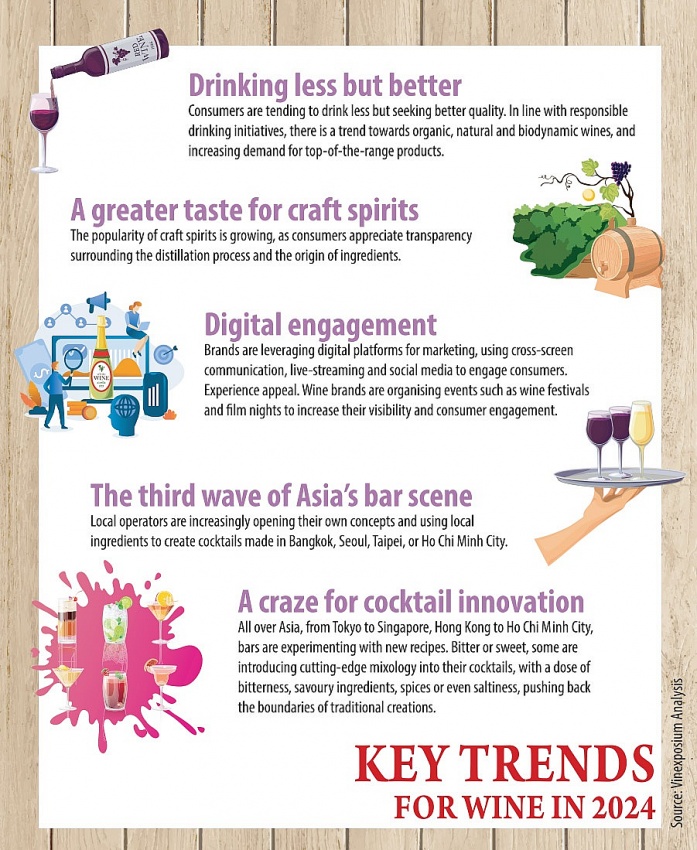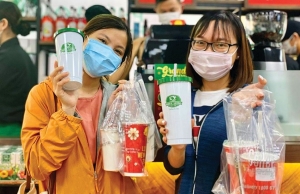Tasty trends in the wine industry
According to a report published by Statista in January, wine e-commerce is a relatively new market that weaves the age-old tradition of winemaking with tools provided by modern tech.
 |
| Vinexpo Academy creates unique experiences With a sustained presence in Asia for over 25 years through the Vinexpo Asia, Vinexposium aims to create not only a trading show but an educational event and a training playground for winemakers, traders, and experts to exchange their knowledge and experiences in developing expertise, encouraging innovation, and promoting excellence. Accordingly, masterclasses, conferences, round tables, prize-giving ceremonies, and tastings on the Vinexpo Academy agenda will comprise 55 prestigious sessions to learn, be inspired by trends, and exchange during the three days of the show. The initiative will bring together renowned experts to meet the demands of the Asian market with high-level programming and relevant market information for buyers in the region. The programmes include 55 masterclasses, 75 experts to lead the different sessions, three days of high-level continuing educational conferences, and major tastings to enable participants to learn, taste, exchange ideas, and be inspired. There will also be round tables focusing on the economic climate for the wine and spirits industry in Asia, and the behaviour of today’s consumers, as well as awards for Asian drinks businesses. |
In the French market, in 2012 around 12 per cent of consumers bought wine online. Wine e-commerce user penetration steadily increased in the following years, reaching 46 per cent in 2021. This rate eventually decreased to 33 per cent in 2024, as the pandemic lockdowns that spurred online spending came to an end. More conventional sommeliers and wine lovers would argue that e-commerce platforms could never substitute the pleasure associated with entering a wine bar and mulling over an exquisite variety of choice before choosing a bottle to take home.
However, the global wine market in the post-pandemic era seems to be defined by a shopping experience touching multiple channels, including out-of-home consumption. Consumers will always go to wine bars, but they may also be tempted by the product range, promotional offers and otherwise difficult to find wine brands and varieties offered exclusively by online retailers.
According to the Global Online Wine market research report in 2023, from 2017 to 2023, online wine sales doubled from $1.4 billion to $3.5 billion. This boom is the result of changing shopping habits, especially during the pandemic, when sales were conducted smoothly thanks to online platforms. It is anticipated to rise at a considerable rate between 2023 and 2031.
The wine e-commerce industry is expected to continue its evolution, with digital technology and customer-centric strategies playing pivotal roles in shaping consumer experiences and preferences. Brands that quickly adapt to these changes, focusing on personalised and technologically advanced marketing strategies, are likely to thrive in the coming year.
In the bloom of e-commerce platforms and the wine e-commerce industry, the return of physical events alike Vinexpo Asia promises to bring new excitement to the industry. Explaining the optimistic estimates, Rodolphe Lameyse, CEO of Vinexposium, said, “Our company recognises the importance of technology and the usage of mobile devices. As such we have an Online Matching Service that brings the right buyers and producers together and allows them to plan their meetings in advance.”
However, physical events are still significant in the wine and spirits industry, as they allow the community to connect, build trust, and taste the products which cannot be replaced by digital devices. “The digital experiences we provide to our customers are done to enhance and enrich their overall experience and engagement with Vinexposium,” Lameyse added. “Everything is in place to ensure this year’s Vinexpo Asia remains the industry’s most powerful meeting place, ready to strengthen the unique bond that has existed between Vinexposium and Hong Kong for more than 25 years.”
 | F&B is still a game for TOP brands With a growth rate of more than 10 per cent per year, the food and beverage market is still a vibrant playground led by big brands. |
What the stars mean:
★ Poor ★ ★ Promising ★★★ Good ★★★★ Very good ★★★★★ Exceptional
Related Contents
Latest News
More News
- GBA Oktoberfest 2025 celebrates German-Vietnam ties (September 29, 2025 | 23:52)
- Showcase AC 2025 set to light up Hanoi stage (September 12, 2025 | 18:06)
- GBA Oktoberfest Vietnam returns with landmark edition (September 07, 2025 | 11:52)
- New Zealand art exhibition to strengthen Vietnam cultural links (August 16, 2025 | 12:16)
- LG art exhibition marks three decades of development in Vietnam (July 31, 2025 | 14:38)
- Maxilite by Dulux launches national contest for painters (July 28, 2025 | 12:16)
- Runners gear up as Sedona SkyRun makes a comeback (June 30, 2025 | 17:28)
- Innovative concert brings symphonic music closer to Vietnamese audience (June 24, 2025 | 09:39)
- Panasonic kicks off Kid Witness News 2025 to enrich children’s summer (June 12, 2025 | 18:25)
- Danang dances in the fireworks limelight (June 09, 2025 | 11:00)

 Tag:
Tag:





















 Mobile Version
Mobile Version